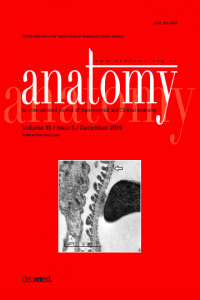Research Article
Year 2019,
Volume: 13 Issue: 3, 200 - 204, 31.12.2019
Abstract
References
- 1. Selcuk I, Tatar I, Huri E. Cadaveric anatomy and dissection in surgical training. Turk J Obstet Gynecol. 2019;16(1):72-5. 2. Dissabandara LO, Nirthanan SN, Khoo TK, Tedman R. Role of cadaveric dissections in modern medical curricula: a study on student perceptions. Anat Cell Biol. 2015;48(3):205-12. 3. Estai M, Bunt S. Best teaching practices in anatomy education: A critical review. Ann Anat. 2016;208:151-7. 4. Sugand K, Abrahams P, Khurana A. The anatomy of anatomy: a review for its modernization. Anat Sci Educ. 2010;3(2):83-93. 5. Winkelmann A. Anatomical dissection as a teaching method in medical school: a review of the evidence. Med Educ. 2007;41(1):15-22. 6. Azer SA, Eizenberg N. Do we need dissection in an integrated problem-based learning medical course? Perceptions of first- and second-year students. Surg Radiol Anat. 2007;29(2):173-80. 7. Cottam WW. Adequacy of medical school gross anatomy education as perceived by certain postgraduate residency programs and anatomy course directors. Clin Anat. 1999;12(1):55-65. 8. Selcuk I. Barut C, Caliskan E. Impact of a gynecologic oncology cadaveric dissection course for surgical training. Anatomy. 2019;13(1):56-60. 9. Smith CF, Finn GM, Stewart J, Atkinson MA, Davies DC, Dyball R, et al. The Anatomical Society core regional anatomy syllabus for undergraduate medicine. J Anat. 2016;228(1):15-23. 10. Jeyakumar A, Dissanayake B, Dissabandara L. Dissection in the Modern Medical Curriculum: An Exploration into Student Perception and Adaptions for the Future. Anat Sci Educ. 2019. 11. Aziz MA, McKenzie JC, Wilson JS, Cowie RJ, Ayeni SA, Dunn BK. The human cadaver in the age of biomedical informatics. Anat Rec. 2002;269(1):20-32. 12. Pais D, Casal D, Mascarenhas-Lemos L, Barata P, Moxham BJ, Goyri-O'Neill J. Outcomes and satisfaction of two optional cadaveric dissection courses: A 3-year prospective study. Anat Sci Educ. 2017;10(2):127-36. 13. Stringer MD, Nicholson HD. Modern approaches to teaching and learning anatomy: Modern models are already being applied. BMJ. 2008;337:a1966.
Year 2019,
Volume: 13 Issue: 3, 200 - 204, 31.12.2019
Abstract
Objectives: The aim of this study was to investigate if student number is a factor for the efficacy of cadaveric demonstrations
in undergraduate anatomy education.
Methods: For a female pelvic anatomy cadaveric demonstration lecture of second-year medical students at the anatomy laboratory
of Hacettepe University School of Medicine, students were divided into 3 groups of 45, 30 and 15 participants. Each group
was further divided into 3 subgroups. Thus, there were 3 groups with 15 participants, 3 subgroups with 10 participants and 3
subgroups with 5 participants (3×15, 3×10, 3×5). After the cadaveric demonstration, the participants were asked if they had
seen the structure previously listed in the checklist or not.
Results: The number of medical students who missed small anatomical structures such as the umbilical artery, ureter or uterine
artery during the cadaveric demonstration significantly decreased as the number of students per cadaver table decreased
(p<0.05). Best results were obtained when the number of students per cadaver table was 5. On the other hand, no significant
difference was found between the groups for missing gross anatomical structures such as the uterus, ovary or uterine tube, irrespective
of the number of participants per cadaver table (p>0.05).
Conclusion: As the number of students per cadaver table decreases, the number of overlooked or missed structures will
decrease.
References
- 1. Selcuk I, Tatar I, Huri E. Cadaveric anatomy and dissection in surgical training. Turk J Obstet Gynecol. 2019;16(1):72-5. 2. Dissabandara LO, Nirthanan SN, Khoo TK, Tedman R. Role of cadaveric dissections in modern medical curricula: a study on student perceptions. Anat Cell Biol. 2015;48(3):205-12. 3. Estai M, Bunt S. Best teaching practices in anatomy education: A critical review. Ann Anat. 2016;208:151-7. 4. Sugand K, Abrahams P, Khurana A. The anatomy of anatomy: a review for its modernization. Anat Sci Educ. 2010;3(2):83-93. 5. Winkelmann A. Anatomical dissection as a teaching method in medical school: a review of the evidence. Med Educ. 2007;41(1):15-22. 6. Azer SA, Eizenberg N. Do we need dissection in an integrated problem-based learning medical course? Perceptions of first- and second-year students. Surg Radiol Anat. 2007;29(2):173-80. 7. Cottam WW. Adequacy of medical school gross anatomy education as perceived by certain postgraduate residency programs and anatomy course directors. Clin Anat. 1999;12(1):55-65. 8. Selcuk I. Barut C, Caliskan E. Impact of a gynecologic oncology cadaveric dissection course for surgical training. Anatomy. 2019;13(1):56-60. 9. Smith CF, Finn GM, Stewart J, Atkinson MA, Davies DC, Dyball R, et al. The Anatomical Society core regional anatomy syllabus for undergraduate medicine. J Anat. 2016;228(1):15-23. 10. Jeyakumar A, Dissanayake B, Dissabandara L. Dissection in the Modern Medical Curriculum: An Exploration into Student Perception and Adaptions for the Future. Anat Sci Educ. 2019. 11. Aziz MA, McKenzie JC, Wilson JS, Cowie RJ, Ayeni SA, Dunn BK. The human cadaver in the age of biomedical informatics. Anat Rec. 2002;269(1):20-32. 12. Pais D, Casal D, Mascarenhas-Lemos L, Barata P, Moxham BJ, Goyri-O'Neill J. Outcomes and satisfaction of two optional cadaveric dissection courses: A 3-year prospective study. Anat Sci Educ. 2017;10(2):127-36. 13. Stringer MD, Nicholson HD. Modern approaches to teaching and learning anatomy: Modern models are already being applied. BMJ. 2008;337:a1966.
There are 1 citations in total.
Details
| Primary Language | English |
|---|---|
| Subjects | Health Care Administration |
| Journal Section | Research Article |
| Authors | |
| Publication Date | December 31, 2019 |
| Published in Issue | Year 2019 Volume: 13 Issue: 3 |
Cite
Anatomy is the official journal of Turkish Society of Anatomy and Clinical Anatomy (TSACA).

